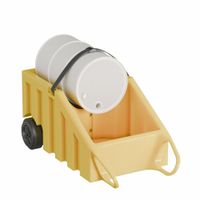Spill containment pallets are used to prevent and manage the accidental release of hazardous liquids, such as chemicals, oils, and other potentially harmful substances, in industrial and commercial settings. These pallets are designed to provide a secondary containment solution, ensuring that any leaks or spills from containers, drums, or tanks are captured and contained, thereby minimizing environmental contamination and enhancing workplace safety.
Typically made from durable materials like polyethylene or steel, spill containment pallets feature a grated surface that allows liquids to drain into a sump or basin below. This design ensures that the containers remain elevated and dry, reducing the risk of corrosion or further leakage. The sump capacity is a critical feature, as it determines the volume of liquid the pallet can safely contain, often adhering to regulatory requirements such as those set by the Environmental Protection Agency (EPA) or the Occupational Safety and Health Administration (OSHA).
Spill containment pallets are commonly used in warehouses, factories, laboratories, and any facility where hazardous materials are stored or handled. They are essential for compliance with environmental regulations, which mandate proper spill management practices to protect soil and water resources. By using these pallets, businesses can avoid costly fines, cleanup expenses, and potential harm to employees and the environment.
Additionally, spill containment pallets contribute to efficient spill response and cleanup, as they localize the spill, making it easier to address. They also support organized storage, as they often come in various sizes and configurations to accommodate different types and numbers of containers. Overall, spill containment pallets are a vital component of a comprehensive spill prevention and response strategy, promoting safety and environmental stewardship.











